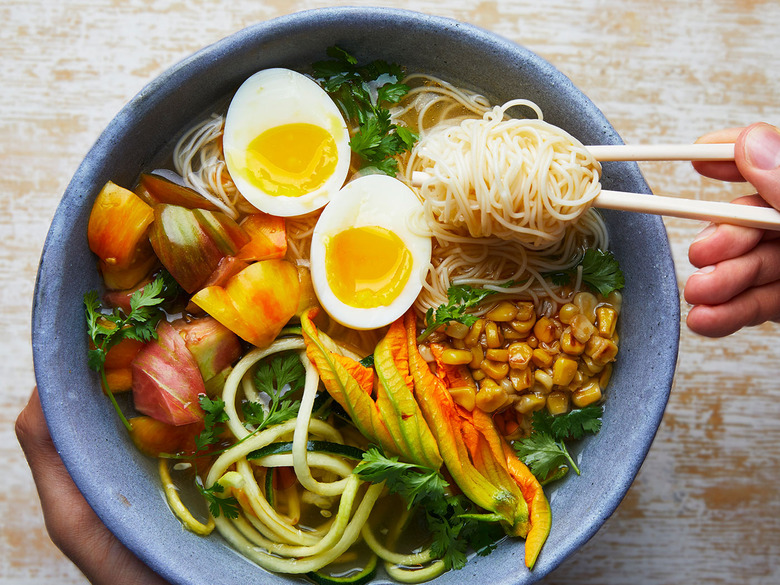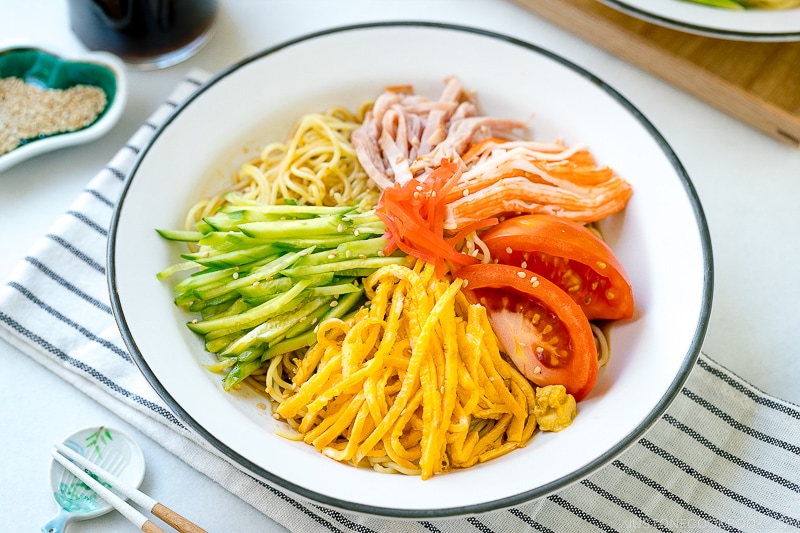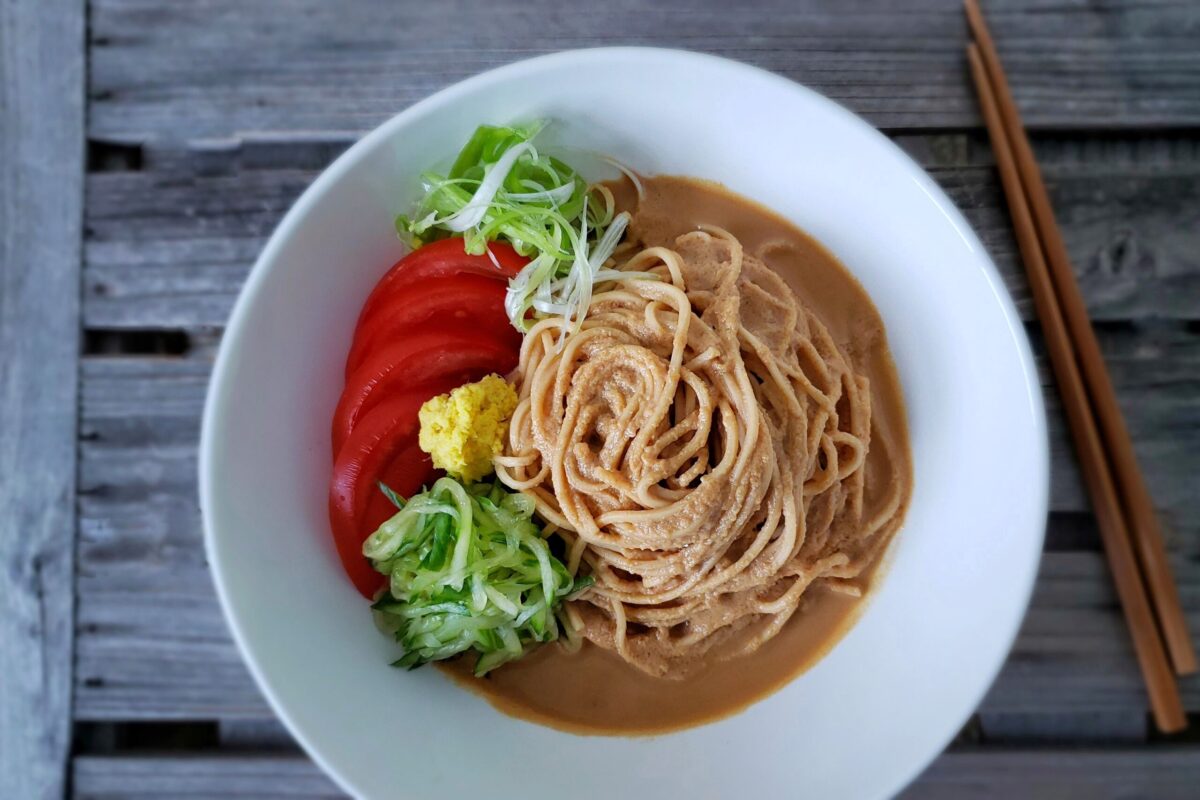Cold Ramen Recipe
Cold ramen recipe? Yes, you read that right! This isn’t your typical steaming bowl of noodles. Cold ramen is a delightful summer dish that’s all about cool, refreshing flavors. It’s a popular choice in Japan, where it’s enjoyed for its light and flavorful nature, especially during the hot summer months.
Think of cold ramen as a fun twist on a classic. It’s all about contrasting textures, with springy noodles, cool broth, and a variety of toppings. The broth is often a light soy sauce or sesame-based blend, perfectly balanced with a hint of vinegar.
The toppings are where you get to be creative, from classic sliced cucumbers and seaweed to more adventurous additions like marinated eggs or even spicy kimchi.
Introduction to Cold Ramen: Cold Ramen Recipe

Cold ramen, also known as “hiyashi chuka” in Japanese, is a refreshing and delicious noodle dish that has gained immense popularity worldwide. Unlike its hot counterpart, cold ramen features chilled noodles served in a cold broth, making it a perfect option for warm weather or a light and satisfying meal.
The origins of cold ramen can be traced back to Japan, where it emerged as a variation of traditional hot ramen. The idea of serving ramen cold likely stemmed from the desire to enjoy a refreshing and comforting meal during the hot summer months.
Over time, cold ramen evolved into a distinct culinary experience, with unique regional variations and creative toppings.
The appeal of cold ramen lies in its refreshing nature and its ability to satisfy without feeling heavy. The chilled noodles offer a delightful contrast to the flavorful broth, while the various toppings add layers of texture and taste. Whether you’re looking for a quick and easy lunch or a satisfying dinner, cold ramen is a versatile and delicious choice.
Cold Ramen Variations
Cold ramen comes in a wide variety of styles, each with its own unique characteristics and regional influences. Some popular variations include:
- Tokyo-style Cold Ramen:This style features thin, straight noodles served in a light soy sauce-based broth with toppings like sliced cucumbers, shredded cabbage, and a boiled egg.
- Nagoya-style Cold Ramen:Known for its thicker, curly noodles and a flavorful broth seasoned with soy sauce, vinegar, and sesame oil. Common toppings include marinated pork, seaweed, and spring onions.
- Chuka-style Cold Ramen:A more modern variation that incorporates influences from Chinese cuisine. This style often features thicker noodles, a savory broth with a hint of ginger, and toppings like sliced pork, vegetables, and a drizzle of chili oil.
The diversity of cold ramen allows for a wide range of flavor profiles and textures. From the refreshing and light Tokyo-style to the more robust and savory Nagoya-style, there’s a cold ramen variation to suit every palate.
Essential Ingredients
A basic cold ramen recipe typically requires a few key ingredients that contribute to its unique flavor and texture:
- Ramen Noodles:The foundation of the dish, ramen noodles provide a chewy and satisfying texture. Choose high-quality noodles made with wheat flour, salt, and water for the best results.
- Broth:The base of the cold ramen, the broth can be soy sauce-based, sesame-based, or vinegar-based. A well-balanced broth should be flavorful and refreshing, complementing the noodles and toppings.
- Toppings:The toppings add variety and depth to the dish. Common toppings include sliced cucumbers, shredded cabbage, marinated eggs, seaweed, and sliced pork.
When selecting ingredients, prioritize quality and freshness. Choose noodles with a good chewiness and a smooth texture. Opt for a flavorful and balanced broth, and select fresh and vibrant toppings.
Preparing the Noodles
Cooking and chilling the ramen noodles is crucial for achieving the perfect texture and refreshing bite. Follow these steps:
- Cook the noodles according to package instructions:Use a large pot of boiling water and cook the noodles until they are al dente, with a slight bite. Overcooked noodles will become mushy and lose their texture.
- Drain the noodles thoroughly:Once cooked, drain the noodles in a colander and rinse them with cold water to stop the cooking process. This will ensure that the noodles are chilled and firm.
- Chill the noodles:Place the drained noodles in a bowl of ice water for a few minutes to further cool them down. This will ensure that the noodles are completely chilled and ready to be served.
By following these steps, you’ll achieve perfectly chilled noodles that are firm, springy, and refreshing.
Creating the Broth

The broth is the heart and soul of cold ramen, adding a flavorful and refreshing base to the dish. Here are some popular broth options:
- Soy Sauce-based Broth:A classic choice, this broth is made with soy sauce, mirin, sugar, and water. It offers a savory and umami-rich flavor profile.
- Sesame-based Broth:This broth features toasted sesame seeds, soy sauce, rice vinegar, and sugar. It has a nutty and slightly tangy flavor that complements the noodles well.
- Vinegar-based Broth:A refreshing and light option, this broth is made with rice vinegar, soy sauce, sugar, and water. It has a slightly tangy and sweet flavor.
Experiment with different broth recipes and adjust the ingredients to your liking. You can add a pinch of chili flakes for a touch of heat or a squeeze of lemon juice for a bright citrusy flavor.
Toppings and Garnishes, Cold ramen recipe

Toppings are an essential part of cold ramen, adding texture, flavor, and visual appeal. Here’s a list of popular toppings:
| Topping | Flavor Profile | Texture | Visual Appeal |
|---|---|---|---|
| Sliced Cucumbers | Refreshing, crisp | Crisp, cool | Bright green, adds a fresh touch |
| Shredded Cabbage | Slightly sweet, crunchy | Crunchy, adds a textural contrast | White, adds a light and airy feel |
| Marinated Eggs | Savory, slightly sweet | Soft, creamy | Yellow, adds a rich and decadent touch |
| Seaweed | Salty, umami-rich | Soft, slightly chewy | Dark green, adds a traditional Japanese element |
| Sliced Pork | Savory, tender | Tender, juicy | Pink, adds a protein source and visual interest |
| Spring Onions | Slightly sweet, pungent | Crisp, adds a textural contrast | Green, adds a fresh and vibrant touch |
| Nori Flakes | Salty, umami-rich | Crisp, adds a textural contrast | Dark green, adds a traditional Japanese element |
| Sesame Seeds | Nutty, slightly sweet | Crunchy, adds a textural contrast | White or black, adds a nutty flavor and visual appeal |
| Chili Oil | Spicy, flavorful | Oily, adds a touch of heat | Red, adds a vibrant color and spicy kick |
Feel free to experiment with different toppings and create your own unique combinations.
Assembling the Dish
Assembling a cold ramen bowl is an art form, requiring careful layering of ingredients for optimal flavor and presentation.
- Place the chilled noodles in a bowl:Make sure the noodles are evenly distributed in the bowl.
- Pour the cold broth over the noodles:Ensure that the noodles are fully submerged in the broth.
- Arrange the toppings:Layer the toppings in a visually appealing manner. You can start with the larger toppings, such as sliced pork or marinated eggs, and then add smaller toppings, like shredded cabbage or spring onions.
- Garnish with additional ingredients:Add a final touch with a sprinkle of sesame seeds, nori flakes, or a drizzle of chili oil.
By following these steps, you’ll create a visually appealing and flavorful cold ramen bowl.
Serving and Enjoying
Cold ramen is best served chilled, with a temperature between 40°F and 50°F. It can be enjoyed as a light and refreshing meal or as a side dish to accompany other Japanese cuisine.
For a complete dining experience, consider serving cold ramen with a side of pickled ginger, edamame, or a light salad. Leftover cold ramen can be stored in the refrigerator for up to 3 days. To reheat, simply microwave it for a few seconds until warmed through.
Enjoy the refreshing and flavorful world of cold ramen!
Last Word

So, ditch the hot ramen for a while and embrace the coolness of cold ramen. It’s a refreshing, flavorful, and surprisingly versatile dish that’s perfect for any summer occasion. Whether you’re a seasoned ramen enthusiast or just looking for something new and exciting to try, cold ramen is sure to become a new favorite.




Post a Comment for "Cold Ramen Recipe"